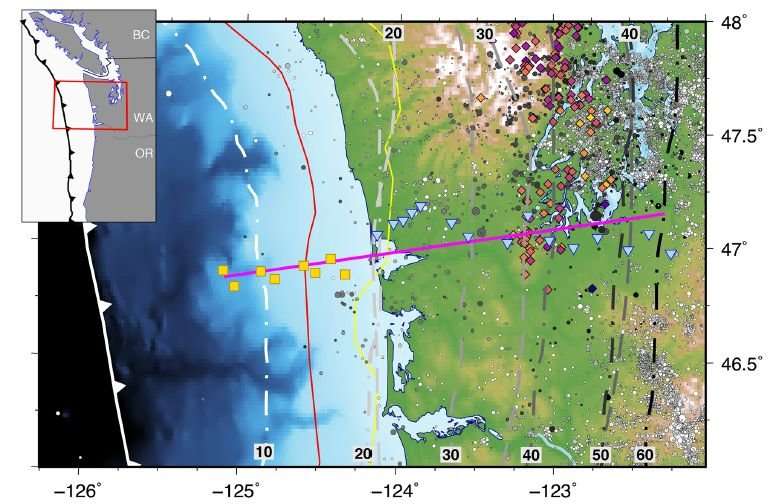Map of the Cascadia forearc region. Credit: Science Advances (2018). DOI: 10.1126/sciadv.aar2982
A team of researchers with the University of Ottawa has used teleseismic data from on- and off-shore sensors to learn more about the low-viscosity layer (LVL) present in a northern part of the Cascadia subduction zone. In their paper published on the open access site Science Advances, the team reports on what they learned.
A tectonic plate originating beneath the Pacific Ocean (off the northwest coast of the U.S. and southwest part of Canada) is slowly being pushed under the North American plate, forming the Cascadia subduction zone. Because of the instability in the area, earthquakes occur. But there has not been a major quake in the region since 1700, making geologists nervous as they try to predict when the next one might be. Complicating this work is a relative lack of seismic activity in the seismogenic zone. In this new effort, the researchers took a new approach to studying the zone—they used teleseismic data from sensors both onshore and offshore to study the low-viscosity layer.
An LVL is a part of the subduction zone containing fluids that have been released from a subducting oceanic plate. Researchers study LVLs because they offer a means for studying subduction zones without using data from the seismogenic zone—seismic waves travel through them more slowly than other parts of the zone. The new teleseismic data offered a new perspective on the LVL that exists in the northern part of the Cascadia subduction zone. The researchers were able to see that the LVL does not extend into the locked zone, which is actually a good thing. Its presence would likely buffer Portland and Seattle during a major shift, resulting in less of an earthquake impact. The placement of the LVL, the team reports, is somewhat of a surprise, but it also helps explain a previously puzzling gap between the edges of the fault zone. The researchers also found that the LVL is very thick in the deeper parts of the interface between the two plates, suggesting it is well developed.
More information: Pascal Audet et al. Fluid pressure and shear zone development over the locked to slow slip region in Cascadia, Science Advances (2018). DOI: 10.1126/sciadv.aar2982
Abstract
At subduction zones, the deep seismogenic transition from a frictionally locked to steady sliding interface is thought to primarily reflect changes in rheology and fluid pressure and is generally located offshore. The development of fluid pressures within a seismic low-velocity layer (LVL) remains poorly constrained due to the scarcity of dense, continuous onshore-offshore broadband seismic arrays. We image the subducting Juan de Fuca oceanic plate in northern Cascadia using onshore-offshore teleseismic data and find that the signature of the LVL does not extend into the locked zone. Thickening of the LVL down dip where viscous creep dominates suggests that it represents the development of an increasingly thick and fluid-rich shear zone, enabled by fluid production in subducting oceanic crust. Further down dip, episodic tremor, and slip events occur in a region inferred to have locally increased fluid pressures, in agreement with electrical resistivity structure and numerical models of fault slip.
Journal information: Science Advances
© 2018 Phys.org























